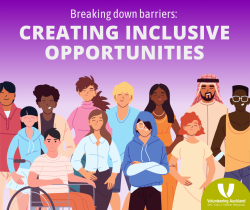Breaking Down Barriers: Creating Inclusive Opportunities for Volunteering

Volunteering has the power to connect people, uplift communities, and create meaningful change. However, not everyone has equal access to volunteer opportunities. Barriers such as transportation, accessibility, and language limitations often prevent individuals from participating fully. By addressing these challenges, leaders of volunteers can foster inclusivity, enabling all people to contribute and benefit from the rich experience of volunteering.
Why Addressing Barriers Matters
Volunteering isn’t just about giving back—it’s about building stronger, more inclusive communities. Removing barriers ensures that:
1. Diverse Perspectives Are Represented
- Inclusive volunteer programmes bring together individuals from varied backgrounds, fostering creativity and innovation.
2. Communities Are Truly Empowered
- When barriers are removed, more people can contribute to solving local challenges, leading to stronger, more connected communities.
3. Social Equity Is Promoted
- Volunteering should be accessible to all, regardless of socio-economic status, ability, or language proficiency. Breaking down barriers ensures equity in participation.
Key Barriers to Volunteering
1. Transportation
- Many people, especially in rural areas or low-income communities, struggle to access volunteer sites due to limited public transport or the costs associated with travel.
2. Accessibility
- Physical and digital spaces for volunteering are not always designed with people with disabilities in mind, excluding a significant portion of the population.
3. Language
- Language barriers can prevent non-native speakers from understanding volunteer expectations, tasks, or communication within the organisation.
Strategies to Remove Barriers
Addressing these barriers requires proactive leadership and thoughtful planning. Here are actionable strategies for overcoming each obstacle:
1. Overcoming Transportation Challenges
Offer Travel Subsidies
- Partner with local governments or businesses to provide discounted public transportation passes or fuel vouchers for volunteers.
Organise Carpool Systems
- Coordinate carpools among volunteers, using apps or communication platforms to facilitate connections.
Bring Opportunities to the Community
- Host volunteer activities in accessible, local venues or create virtual volunteering roles that eliminate the need for travel altogether.
2. Enhancing Accessibility
Conduct Accessibility Audits
- Evaluate physical spaces, communication tools, and digital platforms to identify and address barriers for people with disabilities.
Provide Adaptive Equipment
- Ensure that assistive devices, such as ramps, screen readers, or large-print materials, are available to volunteers who need them.
Flexible Roles and Schedules
- Design volunteer opportunities that accommodate different abilities and energy levels, such as remote tasks or short shifts.
3. Breaking Language Barriers
Multilingual Materials
- Translate recruitment materials, training manuals, and communication into multiple languages spoken in the community.
Cultural Competence Training
- Train staff and existing volunteers to communicate effectively and respectfully across language and cultural differences.
Engage Bilingual Volunteers
- Recruit bilingual volunteers to act as translators or mentors, helping bridge the gap for non-native speakers.
Examples of Inclusive Practices
1. Transportation
- A community food bank could partner with a ride-sharing service to provide free rides for volunteers to and from their distribution center. This initiative could increase participation among individuals who otherwise could not afford transportation.
2. Accessibility
- An organisation offering literacy programmes could invest in wheelchair ramps, adjustable desks, and online meeting tools to ensure people with mobility challenges or sensory impairments could fully participate.
3. Language
- A refugee support organisation could create multilingual training videos and recruited interpreters to assist volunteers who spoke limited English. This could not only expand their volunteer base but also make the environment more welcoming.
The Role of Leaders of Volunteers
Leaders of volunteers play a pivotal role in creating an inclusive environment. Here’s how they can make a difference:
1. Advocate for Inclusion
- Promote the importance of breaking down barriers within your organisation. Advocate for budget allocations to support inclusive practices.
2. Engage Stakeholders
- Collaborate with local businesses, government agencies, and community groups to address common barriers and find innovative solutions.
3. Monitor and Adapt
- Continuously assess the effectiveness of your strategies through feedback from volunteers and community members. Be willing to adapt and improve based on their input.
4. Celebrate Diversity
- Highlight the stories and contributions of diverse volunteers to inspire others and emphasize the value of inclusivity.
The Ripple Effect of Inclusion
When barriers are removed, the benefits extend far beyond individual participants:
- Stronger Communities
Inclusive volunteer programmes build a sense of belonging and empowerment among all members of the community.
- Broader Impact
A more diverse volunteer base brings unique skills and perspectives, enhancing the effectiveness of community initiatives.
- Increased Engagement
People who experience inclusive volunteering often become advocates, encouraging others to get involved.
Conclusion
Creating inclusive volunteer opportunities is not just a moral imperative but a practical one. By addressing transportation, accessibility, and language barriers, leaders of volunteers can unlock the full potential of their communities. The effort to remove these barriers pays off in stronger relationships, a broader reach, and a more equitable society. Volunteering should be a door that’s open to all—and with intentional leadership, it can be.

